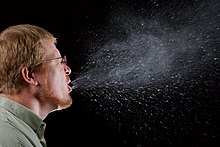Our website is made possible by displaying online advertisements to our visitors.
Please consider supporting us by disabling your ad blocker.
Sneeze
| Sneeze | |
|---|---|
 The function of sneezing is to expel irritants from the nasal cavity. | |
| Biological system | Respiratory system |
| Health | Beneficial |
| Action | Involuntary |
| Stimuli | Irritants of the nasal mucosa Light Cold air Snatiation Allergy Infection |
| Method | Expulsion of air through nose/mouth |
| Outcome | Removal of irritant |
A sneeze (also known as sternutation) is a semi-autonomous, convulsive expulsion of air from the lungs through the nose and mouth, usually caused by foreign particles irritating the nasal mucosa. A sneeze expels air forcibly from the mouth and nose in an explosive, spasmodic involuntary action. This action allows for mucus to escape through the nasal cavity and saliva to escape from the oral cavity.[1] Sneezing is possibly linked to sudden exposure to bright light (known as photic sneeze reflex), sudden change (drop) in temperature, breeze of cold air, a particularly full stomach, exposure to allergens, or viral infection. Because sneezes can spread disease through infectious aerosol droplets, it is recommended to cover one's mouth and nose with the forearm, the inside of the elbow, a tissue or a handkerchief while sneezing. In addition to covering the mouth, looking down is also recommended to change the direction of the droplets spread and avoid high concentration in the human breathing heights.
The function of sneezing is to expel mucus containing foreign particles or irritants and cleanse the nasal cavity. During a sneeze, the soft palate and palatine uvula depress while the back of the tongue elevates to partially close the passage to the mouth, creating a venturi (similar to a carburetor) due to Bernoulli's principle so that air ejected from the lungs is accelerated through the mouth and thus creating a low pressure point at the back of the nose. This way air is forced in through the front of the nose and the expelled mucus and contaminants are launched out the mouth. Sneezing with the mouth closed does expel mucus through the nose but is not recommended because it creates a very high pressure in the head and is potentially harmful.
Sneezing cannot occur during sleep due to REM atonia – a bodily state where motor neurons are not stimulated and reflex signals are not relayed to the brain. Sufficient external stimulants, however, may cause a person to wake from sleep to sneeze, but any sneezing occurring afterwards would take place with a partially awake status at minimum.[2]
When sneezing, humans eyes automatically close due to the involuntary reflex during sneeze.[3]
- ^ "Sneeze". The Free Dictionary. Retrieved April 6, 2012.
- ^ "Sleep On, Sneeze Not". A Moment of Science. Indiana University. Archived from the original on 23 February 2019. Retrieved 2019-02-21.
- ^ "The eye-popping truth about why we close our eyes when we sneeze". NBC News. 2013-04-12. Retrieved 2024-06-10.
Previous Page Next Page


